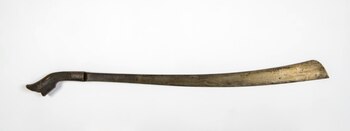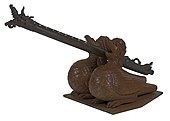| Ladieng | |
|---|---|
 A Ladieng from Aceh, pre-1911. | |
| Type | Klewang sword / Parang (knife) |
| Place of origin | Indonesia (Aceh & North Sumatra) |
| Service history | |
| Used by | Acehnese people, Gayo people, Alas people |
| Specifications | |
| Length | overall length: approx. 66–77 cm (26–30 in) |
| Blade type | Straight single edged |
| Hilt type | Wood, Horn |
The Ladieng (also known as Klewang-Ladieng, Ladeng, Ladeeng, Roedoes Lentik, Rudus Lenti, Sonagang-Klewang) is a sword from Sumatra, Indonesia. It is also commonly known as Parang Lading in Malaysia.
It is originally thought to be an agricultural tool used for cutting brushwood and grass,[1] that has made its way into Malay martial arts, Silat and as a weapon.[2] Unfortunately it is too a convenient weapon of offence by gang robbers.[1]


